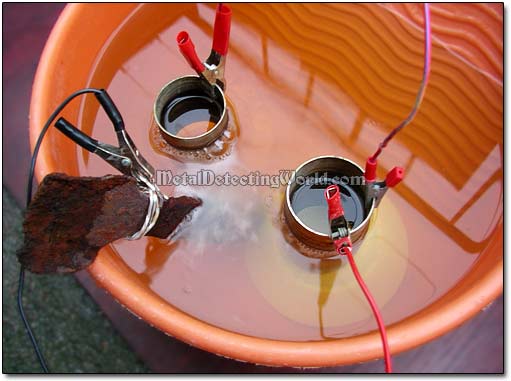Electrolytic Removal of Rust from Relics - A Detailed Illustrated Tutorial, page 20
3. Assembly of Electrolytic Setup: "Line of Sight", Time Required for Complete De-Rusting
4) "Line of Sight"
The process of electrolysis is "line of sight" which means that the current in the electrolyte tends to travel between anodes and cathodes in direct lines rather than around objects that block the "view".
For example, only the side of the iron object that faces the anode - waste electrode, will be de-rusted.
Another example is the gas tank's interior which will not be reached by the current unless you place an anode inside.
Sufficient current can be brought to all surfaces of the iron object by:
1) rotating the iron object - you have to be patient to make sure each side is treated for an equal amount of time. This "modus operandi" is time-consuming but can be sped up a little when a large container is used, so the current can develop a large dynamic "field" (see details on page 14).
2) surrounding the object with anodes - the anodes are placed all around the object to ensure all its surfaces are simultaneously treated and get an even distribution of the current. Since no "blocking effect" takes place, the electrolytic de-rusting will be completed in less time. The more anodes you use the faster you get the job done!
NOTE: All anodes must be electrically connected to each other using connecting sets (described on page 10); thus, forming ONE BIG ANODE (see details in "Setting Correct Polarity" section on next page).
Placing Electrodes on Both Sides of Artifact

 If you have to process a few artifacts at a time, suspend them on a cathode rack between two large anodes - mild-steel plates as shown on a picture below (see details in the "Multiple-Relic Electrolysis" section on page 31).
If you have to process a few artifacts at a time, suspend them on a cathode rack between two large anodes - mild-steel plates as shown on a picture below (see details in the "Multiple-Relic Electrolysis" section on page 31).
Artifacts Are Surrounded by Positive Electrodes in Multiple-Part Electrolysis

NOTE: The form-fitted anodes are highly recommended for special jobs involving iron pieces of unusual shapes.
5) Time Required for Complete De-rusting
Time required to de-rust an iron object will depend on these variables:
• Size of the Object - Obviously, the more the rusty area, the longer time it will take to remove the rust. If an iron artifact is too large to fit in the container, you will have to rotate it at some point - to do its cleaning in two steps - one half at a time. For the process' efficiency, I de-rust all iron relics this way.
• Amount of Current/Voltage Used - The more current/voltage, the faster the process, but one must keep the current/voltage settings within allowable ranges to avoid destroying your electrolysis setup and/or compromising your safety (details will be in the "Controlling Voltage and Current" section).
• Amount of Rust on the Object - Typical cleaning time for the moderately rusted objects is 4-6 hours. Heavily rusted objects can be de-rusted in 12-36 hours.
• Amount of Rusted Cracks and Crevices on the Object - It usually takes a longer while to remove rust from the cracks and crevices than from the smooth surfaces. It can take a long time to clean up badly pitted and rusted iron objects.
• Amount of Anodes of Adequate Sizes Used - The fewer surfaces that are not in direct view of the anode (line of sight), the faster the process will go. So the more anodes you use to provide the line-of-sight for most of the iron object's areas, the less time you will need for complete derusting.
NOTE: There is no risk of over-treating an iron artifact using electrolysis as the de-rusted iron is not affected by the process, and, therefore, the artifact may undergo the electrolytic de-rusting indefinitely as long as the current continues to flow to give it protection from corrosion.
 If you need to stop the process and leave the iron object to be de-rusted in the electrolyte overnight, DO NOT switch the power off! You should switch the voltage to 12 volts, turn the amperage down to a miniscule amount (≤1 amp), and have this small current flowing through the iron object to ensure it is protected from rusting.
If you need to stop the process and leave the iron object to be de-rusted in the electrolyte overnight, DO NOT switch the power off! You should switch the voltage to 12 volts, turn the amperage down to a miniscule amount (≤1 amp), and have this small current flowing through the iron object to ensure it is protected from rusting.
NOTE: When you do not conduct the electrolytic derusting, DO NOT leave the container with the electrolytic solution outdoors under freezing temperatures! If left in the cold environment, the sodium carbonate solution will freeze at 30° Fahrenheit, and expansion of the solidified electrolyte may very well cause freeze cracks and breaks of the parts left in the container.